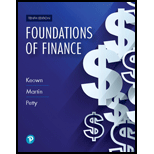
To discuss: The difference between debentures and mortgage bonds.
Explanation of Solution
The difference between debentures and mortgage bonds are as follows:
A debenture can be termed as any unsecured long-term debt. Because these bonds are unsecured, the earning capacity of the issuing organization is of big worry to the bondholders. They are additionally seen as being extra risky than secured securities and therefore, must furnish the investors with a better return than secured bonds give. Frequently the issuing company tries to give some assurance to the holder through the disallowance of any extra encumbrance of assets.
This disallows the upcoming issuance of secured long-term debt that would additionally connect the company's assets and leave the bondholders fewer secured. In terms of the issuing firm, the main benefit of debentures is that no property must be secured by them. This enables the firm to give debt and still save some future acquiring power.
A mortgage bond is a type of bond that is secured by a lien on real property. Normally, the actual value of the real property is higher than that of the mortgage bonds which are issued. This gives the mortgage bondholders an edge of protection in the occasion the market value of the secured property decreases.
On account of foreclosure, the trustees have the ability to sell the secured property and utilize the returns to pay the bondholders. If the returns from such sale don't cover the bonds, the bondholders become general creditors, like debenture bondholders, for the unpaid segment of the debt.
Want to see more full solutions like this?
Chapter 7 Solutions
FOUNDATIONS OF FINANCE-MYFINANCELAB
- No chatgptPlease don't answer i will give unhelpful all expert giving wrong answer he is giving answer with using incorrect values.arrow_forwardPlease don't answer i will give unhelpful all expert giving wrong answer he is giving answer with incorrect data.arrow_forward4. On August 20, Mr. and Mrs. Cleaver decided to buy a property from Mr. and Mrs. Ward for $105,000. On August 30, Mr. and Mrs. Cleaver obtained a loan commitment from OKAY National Bank for an $84,000 conventional loan at 5 percent for 30 years. The lender informs Mr. and Mrs. Cleaver that a $2,100 loan origination fee will be required to obtain the loan. The loan closing is to take place September 22. In addition, escrow accounts will be required for all prorated property taxes and hazard insurance; however, no mortgage insurance is necessary. The buyer will also pay a full year's premium for hazard insurance to Rock of Gibraltar Insurance Company. A breakdown of expected settlement costs, provided by OKAY National Bank when Mr. and Mrs. Cleaver inspect the uniform settlement statement as required under RESPA on September 21, is as follows: I. Transactions between buyer-borrower and third parties: a. Recording fees--mortgage b. Real estate transfer tax c. Recording fees/document…arrow_forward
- finance subjectarrow_forwardCould you help explain, what is the complete salary survey analysis, and ensuring the data is relevant and up-to-date? What is the job evaluation and compensation plan? How to ensure the final report is comprehensive, clearly structured, and aligned with the company vision?arrow_forwardThe maturity value of an $35,000 non-interest-bearing, simple discount 4%, 120-day note is:arrow_forward
- Carl Sonntag wanted to compare what proceeds he would receive with a simple interest note versus a simple discount note. Both had the same terms: $18,905 at 10% for 4 years. Use ordinary interest as needed. Calculate the simple interest note proceeds. Calculate the simple discount note proceeds.arrow_forwardWhat you're solving for Solving for maturity value, discount period, bank discount, and proceeds of a note. What's given in the problem Face value: $55300 Rate of interest: 10% Length of note: 95 days Date of note: August 23rd Date note discounted: September 18th Bank discount rate:9 percentarrow_forwardAll tutor giving incorrect solnarrow_forward
 Cornerstones of Financial AccountingAccountingISBN:9781337690881Author:Jay Rich, Jeff JonesPublisher:Cengage LearningPrinciples of Accounting Volume 1AccountingISBN:9781947172685Author:OpenStaxPublisher:OpenStax College
Cornerstones of Financial AccountingAccountingISBN:9781337690881Author:Jay Rich, Jeff JonesPublisher:Cengage LearningPrinciples of Accounting Volume 1AccountingISBN:9781947172685Author:OpenStaxPublisher:OpenStax College


